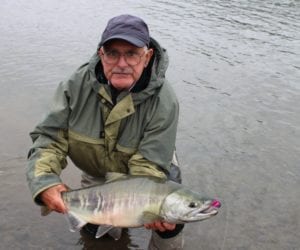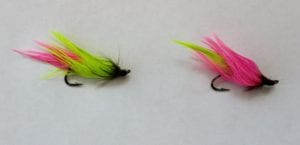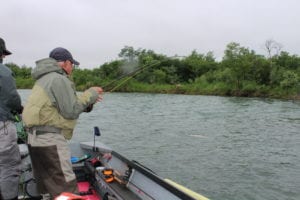- Joined
- Feb 26, 2009
- Messages
- 277,087
- Reaction score
- 8
A cast across the current: the line began to swing round, gradually, with the help of a mend or two, taking on a lovely arc. Suddenly, it went heavy, for all the world as if the fly had snagged up. The brain and rod arm responded with a firm lift, and the first chum of the trip took off in a powerful run towards mid-river. The occasional leap added to the excitement. Something between 5 and 10 minutes later, our guide for the day, Brad Duncan, quickly unhooked and released a chum of around 10 pounds. Hard work, but satisfying!
I remember that day vividly and will do so for a long time. I seemed to hook chum one after the other; many performed the usual aerobatics and in so doing threw the barbless hook, but this is all part of the excitement. An equal, if not greater number came – *if somewhat grudgingly – near the shore and were safely released.

Rod with a rather nice chum.
The river was far higher than when I did the trip at the same time last year. Winter flow had devastated the camp on the Kanektok River established by our guides, Dave Duncan & Sons, and it had now been re-sited, but was otherwise the same: two-man tents, toilets, shower and kitchen and food tent.
Last year, I went all out for the abundant sockeye, and enjoyed the high-speed, unpredictable, often spectacular fight. This time, the sockeye seemed no less numerous, but the chum were running in much greater numbers and a bigger average size than before, so I set my sights on them. As I do very little fly fishing in the UK, I quickly felt the urge to bag up!
This is classic salmon fishing: a cast across and slightly upstream, an upstream mend or two and then the line swinging round and taking on that wonderful tight swinging curve, presenting the fly in front of the fish and provoking a take…
As for fly colours, pink ruled. This, apparently, is not unusual. Another killing colour appears to be green. I have seen flies incorporating both colours and even whites and beige. I tied up quite a few prior to the trip and even ‘invented’ a couple of my own; the Neapolitan (with red rear and green at the front end) and the Candy Floss Killer (colours in reverse order) I tied both using fluorescent rabbit strip on sizes 4 and 6 salmon irons. Both worked – predictably, I have to admit!

The ‘Neopolitan’ and the ‘Candy Floss Killer’.
But all the same it was satisfying to tie up these creations at home, dreaming of what they might produce and then, several thousand miles away, to use them to take such staggering fish.
In the classic salmon fishing way, size of fly also played a role. The fish showed a preference from one day, or part of a day, to another. I gathered that this may have something to do with the arrival of fresh fish on a tide. The game changes constantly. We could only put ourselves in the hands of our guides and results were excellent.

Richard Teil and guide, ‘Cutler’ display a hefty king salmon
This year I thought I would experiment with a slightly lighter rod and took with me a 10’ #7, self-built using a Bloke blank. I can recommend these blanks and I ended up using this rod for most of the fishing. And mostly I was catching double-figure chum. The rod took on a hair-raising curve at times but it did the job, even when fish needed to be persuaded to leave fast water and be more cooperative. And moving up to a chunky #9 on a couple of occasions did not seem to make the job of playing those fish any easier.
Just as important, if not more important, is the line-profile as it determines whether the fly will be presented properly. Of course, the factors of depth and current speed need to be judged. The line which worked in most situations was a #7 floater with 10’ of medium-sink tip. As ever, our guides had an acutely-developed sense of what type of line and size of fly to use.
A question commonly asked is: why do salmon take or attack anything in fresh water? And does it really matter? Most salmon flies seem to me to be fairly fanciful, as the ones I was using certainly were, and can only be described as lures. They cannot really represent much in the way of food to a salmon. What a salmon does to a lure may simply represent aggression, the urge to see off or kill anything perceived as a threat, or anything which gets in the way of the act of procreation which, ironically for Pacific salmon species, is immediately followed by death. Or it may be all a result of hormonal change which triggers aggression. The possibilities are many. And we may never get to the bottom of it all.
It may also simply be that the transition from sea water to fresh is not completed instantaneously, but more gradually. Hence the feeding instinct may still be present after entering the home river. Who knows?
But let’s get back to the actual fishing. Another consequence of high water was that the minor, almost still side-channels I’d found on my previous trip had now become 4 feet deep or more side-rivers in their own right and with a very healthy flow. These provided many additional points for chum and other salmon species running up the river to rest in. Some of these areas were far too deep to wade and could only be fished from an anchored boat. Others were little more than knee-deep and comfortably fishable.

Alaska is the kind of remote place, devoid of human habitation, of seemingly endless wilderness and filled with sky, water and distant mountains, which makes you reflect. It directs your mind to the basic facts of life.
To see fish queuing up and ‘marching’ upriver like things possessed, ‘eager for immortality’ to use Henry Williamson’s phrase, hell-bent on propagating the species, programmed now only to spawn and die, and acting, in scientific terms, as ‘gene survival machines’ gives some food for thought. I remember noting last year, when playing lively sockeye, that whenever I slackened off a bit on a hooked fish, its immediate response was to re-join the column of fish making its way up-river. Philosophers and others have from time immemorial sought a purpose in existence. The only discernible purpose in this particular existence seems to be ensuring that life, the species, continues. Beyond that, it is hard to say.
To find out more about guided trips with Dave Duncan & Sons, look here: Alaska Fly Fishing Guide - Alaska Kanektok River - Leopard Rainbow Trout, King Salmon, Silver Salmon, Sockeye,and Grayling - Outfitter - Flyfishing and float trips - lodge camp
For more information on Bloke blanks and rods: see: http://www.blokerods.co.uk/index.html and also: www.ebay.co.uk/str/blokeflyrods
Rod Sturdy.
Rod began fishing in his local park lake at the age of twelve, and from there he graduated to chub and roach from the river Tees in North Yorkshire. He now lives in Surrey within striking distance of the river Mole, as well as the Medway and the Eden in Kent and does a lot of surface carp fishing on small waters in the area. Latterly he has enjoyed winter fishing on the Test in Hampshire. He has contributed numerous articles on various angling subjects and personalities to ‘Waterlog’ magazine, as well as many posts on environmental and political subjects in support of the work of the Angling Trust on the ‘Fishing Magic’ website (www.fishingmagic.com)
He remains a passionate angler as well as a member of, Ambassador for, and promoter of the Angling Trust; do join him as a valued member.
I remember that day vividly and will do so for a long time. I seemed to hook chum one after the other; many performed the usual aerobatics and in so doing threw the barbless hook, but this is all part of the excitement. An equal, if not greater number came – *if somewhat grudgingly – near the shore and were safely released.

Rod with a rather nice chum.
The river was far higher than when I did the trip at the same time last year. Winter flow had devastated the camp on the Kanektok River established by our guides, Dave Duncan & Sons, and it had now been re-sited, but was otherwise the same: two-man tents, toilets, shower and kitchen and food tent.
Last year, I went all out for the abundant sockeye, and enjoyed the high-speed, unpredictable, often spectacular fight. This time, the sockeye seemed no less numerous, but the chum were running in much greater numbers and a bigger average size than before, so I set my sights on them. As I do very little fly fishing in the UK, I quickly felt the urge to bag up!
This is classic salmon fishing: a cast across and slightly upstream, an upstream mend or two and then the line swinging round and taking on that wonderful tight swinging curve, presenting the fly in front of the fish and provoking a take…
As for fly colours, pink ruled. This, apparently, is not unusual. Another killing colour appears to be green. I have seen flies incorporating both colours and even whites and beige. I tied up quite a few prior to the trip and even ‘invented’ a couple of my own; the Neapolitan (with red rear and green at the front end) and the Candy Floss Killer (colours in reverse order) I tied both using fluorescent rabbit strip on sizes 4 and 6 salmon irons. Both worked – predictably, I have to admit!

The ‘Neopolitan’ and the ‘Candy Floss Killer’.
But all the same it was satisfying to tie up these creations at home, dreaming of what they might produce and then, several thousand miles away, to use them to take such staggering fish.
In the classic salmon fishing way, size of fly also played a role. The fish showed a preference from one day, or part of a day, to another. I gathered that this may have something to do with the arrival of fresh fish on a tide. The game changes constantly. We could only put ourselves in the hands of our guides and results were excellent.

Richard Teil and guide, ‘Cutler’ display a hefty king salmon
This year I thought I would experiment with a slightly lighter rod and took with me a 10’ #7, self-built using a Bloke blank. I can recommend these blanks and I ended up using this rod for most of the fishing. And mostly I was catching double-figure chum. The rod took on a hair-raising curve at times but it did the job, even when fish needed to be persuaded to leave fast water and be more cooperative. And moving up to a chunky #9 on a couple of occasions did not seem to make the job of playing those fish any easier.
Just as important, if not more important, is the line-profile as it determines whether the fly will be presented properly. Of course, the factors of depth and current speed need to be judged. The line which worked in most situations was a #7 floater with 10’ of medium-sink tip. As ever, our guides had an acutely-developed sense of what type of line and size of fly to use.
A question commonly asked is: why do salmon take or attack anything in fresh water? And does it really matter? Most salmon flies seem to me to be fairly fanciful, as the ones I was using certainly were, and can only be described as lures. They cannot really represent much in the way of food to a salmon. What a salmon does to a lure may simply represent aggression, the urge to see off or kill anything perceived as a threat, or anything which gets in the way of the act of procreation which, ironically for Pacific salmon species, is immediately followed by death. Or it may be all a result of hormonal change which triggers aggression. The possibilities are many. And we may never get to the bottom of it all.
It may also simply be that the transition from sea water to fresh is not completed instantaneously, but more gradually. Hence the feeding instinct may still be present after entering the home river. Who knows?
But let’s get back to the actual fishing. Another consequence of high water was that the minor, almost still side-channels I’d found on my previous trip had now become 4 feet deep or more side-rivers in their own right and with a very healthy flow. These provided many additional points for chum and other salmon species running up the river to rest in. Some of these areas were far too deep to wade and could only be fished from an anchored boat. Others were little more than knee-deep and comfortably fishable.

Alaska is the kind of remote place, devoid of human habitation, of seemingly endless wilderness and filled with sky, water and distant mountains, which makes you reflect. It directs your mind to the basic facts of life.
To see fish queuing up and ‘marching’ upriver like things possessed, ‘eager for immortality’ to use Henry Williamson’s phrase, hell-bent on propagating the species, programmed now only to spawn and die, and acting, in scientific terms, as ‘gene survival machines’ gives some food for thought. I remember noting last year, when playing lively sockeye, that whenever I slackened off a bit on a hooked fish, its immediate response was to re-join the column of fish making its way up-river. Philosophers and others have from time immemorial sought a purpose in existence. The only discernible purpose in this particular existence seems to be ensuring that life, the species, continues. Beyond that, it is hard to say.
To find out more about guided trips with Dave Duncan & Sons, look here: Alaska Fly Fishing Guide - Alaska Kanektok River - Leopard Rainbow Trout, King Salmon, Silver Salmon, Sockeye,and Grayling - Outfitter - Flyfishing and float trips - lodge camp
For more information on Bloke blanks and rods: see: http://www.blokerods.co.uk/index.html and also: www.ebay.co.uk/str/blokeflyrods
Rod Sturdy.
Rod began fishing in his local park lake at the age of twelve, and from there he graduated to chub and roach from the river Tees in North Yorkshire. He now lives in Surrey within striking distance of the river Mole, as well as the Medway and the Eden in Kent and does a lot of surface carp fishing on small waters in the area. Latterly he has enjoyed winter fishing on the Test in Hampshire. He has contributed numerous articles on various angling subjects and personalities to ‘Waterlog’ magazine, as well as many posts on environmental and political subjects in support of the work of the Angling Trust on the ‘Fishing Magic’ website (www.fishingmagic.com)
He remains a passionate angler as well as a member of, Ambassador for, and promoter of the Angling Trust; do join him as a valued member.
Last edited by a moderator:
